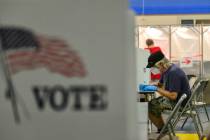STEVE SEBELIUS: Ultimately, most everybody agrees on green power
It would be nice if we could generate all the energy we need without contributing to climate change while at the same time protecting the environment from the impacts of power generation.
It would be nice, but it’s not always going to be possible.
That’s the obvious tension between an executive order issued last week by Republican Gov. Joe Lombardo and a climate strategy document issued in 2021 by then-Democratic Gov. Steve Sisolak.
Most particularly concerning the use of natural gas — currently Nevada’s most popular in-state source of power — the two documents are as different as the two men who oversaw their production.
“In order to meet Nevada’s long-term goal of zero or near-zero greenhouse gas (GHG) emissions by 2050, transitioning away from natural gas is necessary,” the 2021 document reads. “While Nevada’s electricity sector transitions from fossil fuels to zero-emissions renewables, the state must also transition from fossil-fuel combustion in homes and commercial buildings in the form of burning gas for cooking, hot water and space heating.”
Lombardo’s executive order says the opposite: “The state’s energy policies shall ensure all consumers and businesses continue to have diverse energy options available to them in their homes and businesses, including electric and natural gas service, energy efficiency and renewable energy sources.”
The Sisolak-era climate strategy mentions climate change 147 times in its 255 pages; Lombardo’s five-page order mentions it only once, in passing. But both documents acknowledge the state’s goal — now enshrined in Article 4, Section 39 of the state constitution — to reach 50 percent renewable energy generation by 2050.
But where the old climate strategy focused heavily on transitioning to green power sources as quickly as possible, Lombardo’s administration puts the emphasis elsewhere: “The state’s energy policy will be focused on developing and maintaining a robust, diverse energy supply portfolio and a balanced approach to electric and natural gas energy supply and transportation fuels that emphasizes affordability and reliability for consumers.”
The all-of-the-above approach, Lombardo notes, will include “solar, wind, geothermal, hydropower, natural gas (for both electric generation and direct use in homes and businesses), hydrogen, energy storage and other resources.”
The Lombardo plan will delight his supporters (not to mention Nevada’s utilities) as much as the Sisolak plan disheartened them.
But the great irony is that there’s not much dissent here: Almost everybody — from the most ardent environmentalist to the richest coal company executive — realizes that ultimately, renewable power will generate 100 percent of the energy we use. The only difference is how soon we get there, and what we do on the journey.
That’s why it’s ironic that environmentalists have become some of the most high-profile opponents of initiatives to produce more green power in Nevada and hasten the day when coal and natural gas electricity generation is something we’ll see in museums.
They’ve objected to a geothermal project in Northern Nevada, on grounds that it will threaten the habitat of a rare toad. They’ve objected to a lithium mine on grounds that it will threaten a rare wildflower. The recent designation of the Avi Kwa Ame National Monument will kill a wind farm planned for a portion of that land. The developer of a wind farm project near Searchlight withdrew the idea in 2017 after environmentalists said it would harm bald eagles and desert tortoises. The Ivanpah solar project near Primm drew objections before it was finally opened.
Environmentalists argue renewable projects should go in urban areas — on rooftops, solar gardens, parking lots and infill areas — rather than disturbing pristine wilderness. That, and more conservation, is the way to go, they say.
But as we increasingly turn to electric cars and electric appliances and continue to turn desert into subdivisions, we need more renewable energy, in large, utility-scale projects. Conservation and rooftop solar is not enough. And that reality won’t change, no matter who lives in the Governor’s Mansion.
Some day, when our energy comes from fusion reactors, is distributed wirelessly by Tesla coils and is finally too cheap to meter, these concerns will be a distant memory. But for now, in this reality, choices have to have to be made. While we should do everything we can to preserve as much of nature as we can, mindful that every action in an ecosystem affects us all, we should also realize that when a choice has to be made, we have to keep the lights on.
Contact Steve Sebelius at SSebelius@reviewjournal.com or 702-383-0253. Follow @SteveSebelius on Twitter.
























